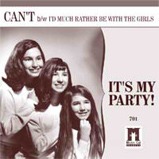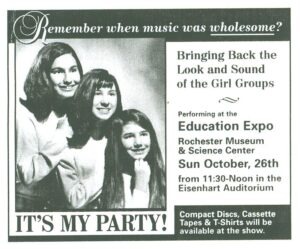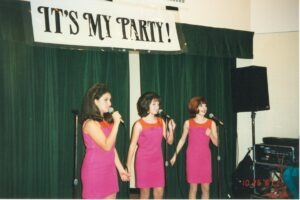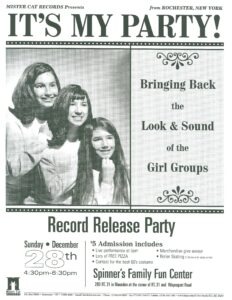Jul 27 | JohnG

The cover of the “Can’t” CD Single from 1997
I’d like to tell you the story of the release of the IT’S MY PARTY! single entitled “Can’t” b/w “I’d Much Rather Be With the Girls.” It’s hard to believe that so much time has past since this recording, and I’d like to write down my recollections of this project before I lose any more memory of the events as they unfolded. Fortunately, we keep very good records of the recording sessions as well as saving artifacts through the years.
IT’S MY PARTY! got back into the studio in 1995 with the intention of recording and releasing a single. The group was in a state of flux for the previous two years, but the time seemed right in ’95, as new candidates auditioned for the vocal lineup and had shown potential.
I thought it would be a nice tribute to the original girl group sound to try to recreate one of the thousands of great tunes to choose from. I always liked Donna Lynn’s version of “I’d Much Rather Be With the Girls,” a Rolling Stones song from their album, Metamorphosis, recorded in 1965. Besides paying out the proper mechanical royalties, we needed to ask permission to change the name from “I’d Much Rather Be With the Boys,” to “I’d Much Rather Be With the Girls.” With permission from the publisher granted, we proceeded to track this one in the spirit of the Donna Lynn version.
We decided to rent the large room at the Penfield Baptist Church on Penfield Road in Penfield, NY for the recording of “I’d Much Rather Be With the Girls.” The price for the day was more than reasonable, and we thought that the large room would give us the big sound present on the original recording. Calvin May, the engineer, set up a microphone in the back of the room to capture the ambience of the drum set. Combining that ambient track with the close microphones created exactly the effect we were looking for. The tracking date was September 1, 1995. The take that we decided to work with was take-three.
We brought in musician Ted Paris to play bass on the track. Ted had played in various sixties revival bands and knew the style we were looking for. Ted also brought along his Rickenbacker twelve-string electric, the same instrument used on Donna Lynn’s version. Besides playing bass, Ted overdubbed many of the guitar tracks, including the twelve-string. Walt O’Brien, whom I will talk about later in this post, played the guitar foundation track, as well as some of the guitar overdubs. We ended up with a total of seven guitar tracks on our recording. As far as the percussion went, Billy Eberts played the glockenspiel, while I played the drum set.
Adding the lead vocal track was a challenge, the would-be singers lacked any real studio experience. We tried a few different vocalist before shelving the project. Then finally, in late 1996, the group enjoyed its strongest singer in years with Vanessa joining the group and taking on lead vocals. We also added Aubrey to the group, a great backup singer whose voice blended well and sat very nicely in the mix. Vanessa and Aubrey were friends from middle school. We were now in a position to complete this track. It was serendipitous that “I’d Much Rather Be With the Girls” was a perfect fit for Vanessa’s lead vocal. I remember posting the word “than” to the studio wall on a piece of paper so she wouldn’t sing the word “then.” We double-tracked Vanessa’s lead using an AKG 414 microphone. We completed the final backing vocal track on March 29, 1997. I guess you should never give up on your dreams, because the finished product was well worth the wait!
I wanted an original recording for the A-side of the project. As I mentioned earlier, Walt O’Brien played guitars on the “I’d Much Rather Be With the Girls” recording. Walt was, and still is, one of the finest musicians in the Rochester area. He cut his teeth on sixties music by listening to his older sister’s records. Walt is a natural, able to pick up, and master, virtually any instrument he touches. Much like Paul McCartney, Walt could easily multi-track himself as an entire ensemble, then sing lead and backup vocals over the top. Walt is also a prolific songwriter; at my request, he provided me with a cassette tape of songs he had written. I listened to the tune “Can’t,” originally recorded in the ’80s by Walt’s band called the Insiders. “Can’t” intrigued me, it had the obvious hooks and infectious melody, the Mersey-beat feel with walking guitar lines and driving harmonica, but there was more. I really liked the seventh chord vocal harmony, and the one bar of two beats that gave the song an interesting twist. So, “Can’t” became the choice for the plug side.
We recorded “Can’t” at Hat n’ Hat Studio in Penfield, NY. Many local and out-of-town groups enjoy the ambiance of that tiny studio, and it would remain the main recording facility for IT’S MY PARTY! through the years. Hat n’ Hat has two rooms and a small control room. Each room can be used for recording. Room one is larger and carpeted, it’s “drier” or “damper” than room two, which is tiled a livelier. The control room is fairly neutral. Sometimes vocals are recorded in the control room with the singers listening to the payback monitors rather than using headphones. We began the recording of “Can’t” on November 24, 1995.
I brought Walt into the studio to play the guitar tracks. We raised the key of the song to C to fit the vocal range of a female vocalist. Walt also played the harmonica solo as well, the only harmonica to date on any IT’S MY PARTY! recording. Calvin May added the final bass guitar track, as well as engineering the recording. The tracking consisted of three microphones on the drums, bass, five guitar tracks, harmonica, hand claps, and tambourine. Walt is one of the best tambourine players I have ever heard. The bass was re-tracked by Calvin on November 2, 1996. We sure took a long time on this, but, again, we were searching for the right vocalists. Vanessa sang lead, and Vanessa and Aubrey both sang the backups. You can clearly hear Aubrey’s voice making the seventh in the harmony.
We took the master tape to DB Plus in New York City to have Gene Paul master the single. It was nice having another set of ears on the project, especially a guy with Gene’s resume. He made some great suggestions for our next tracking and mixing sessions. And, I must say, he wasn’t too thrilled with our ’60s styled faux stereo mix of “Can’t.” Most of the 45 rpms back in those days were mixed in mono, with all the instruments and vocals in the center of the mix. Keep in mind that these songs were mixed for optimum sound from a single car radio speaker, where most people at that time became exposed to new music. Record companies began producing stereo records for stereo equipment, which was on the rise in the late fifties and sixties. The information from the original mono records would come out of a stereo system equally in both the left and right speakers, but this was not the effect stereophiles were looking for. Engineers went back to the master tapes and remixed, but what they had to work with consisted of two, three, or maybe four tracks. Usually the lead vocals on one track, the backing vocals on another, the basic music tracks on the third and any sweeteners, like hand claps and tambourine, maybe on a fourth. That really didn’t leave a lot of room for separation into left and right channels. Most of the time they would load the music on one side and the vocals on the other, this could create an irritating effect where, if the vocals dropped out, your ear missed that information, creating an imbalance of sound. If you listen to “Can’t,” that is precisely what’s going on. We could have balanced the stereo field, but got a little too cute with this mix trying to replicate a four track effect. Remember, we had five guitar tracks, and we could have balanced them equally across the stereo field. Gene really took us to task on that mix, and we never tried that again. On a side note, Phil Spector was never a fan of stereo. He liked the full, fat sound of mono; the meddled effect of mono also made it more difficult to pick out individual instruments, and in a age of fierce competition, more difficult to copy a producer’s techniques.

“Judy’s Turn To Cry” picture sleeve
Calvin designed the sleeve of the CD, which was inspired by the Lesley Gore picture sleeve for “Judy’s Turn to Cry” b/w “Just Let Me Cry.” The inspiration came to Calvin and me over a meal at Dell Taco in Henrietta, NY — long since closed. We particularly liked the monochrome printing on the Lesley Gore Picture sleeve, and wanted to produce the same effect. Here again, we perhaps reached too far. Our CD replicator was a sort of one-stop, providing in-house printing. While this was convenient, I’m not sure they knew what they were doing when it came to printing anything out of the ordinary. Calvin suggested we print in true monochrome. Rather than approximating the one-color by using the four-color printing process, we wanted the pure one color mixed and loaded into the printing press, the end result would be a grayscale of that particular color. The replicator said that, in order to do this, they would have to stop all production, purge the machines, and set up our one-color, adding an additional expense to the project. We agreed, determined to make this look like an old ’60s picture sleeve. The cassette proofs came back from the manufacturer before the CD, and boy was I upset. The printing looked just awful, the product was dark, with black ink clearly present. Obviously, black ink had leached into our printing from somewhere. I wondered who proofed this thing before they sent it along to us! I was on my way to the Grey Cup football game in Edmonton, and steaming mad! I cooled off in Toronto, so I could enjoy the cross Canada trip. After sending the sample cassettes back, with few apologies from the replicator, we eventually received a new batch of passable cassette covers. The CD jackets ended up looking okay, but this incident held up production, and they arrived a few months after the cassettes.

Advertisement for Educational Expo
The “Can’t” cassingle was available for our performance at the Eisenhart Auditorium on East Avenue in Rochester, NY. The girls performed to pre-recorded music from 11:30-noon on October 26, 1997 as part of a larger event called the Educational Expo. And now for one of the best kept secrets of the group; we only had two singers on these recordings, that makes a duo, not a girl group. Insert Lorraine, a friend of mine’s daughter, into the photo shoot, and voila, IT’S MY PARTY! was a girl group, at least for appearances sake. Just in time for the Educational Expo show, we welcomed Roseanna as our third singer. This show was their second performance as a trio.

IT’S MY PARTY! (Vanessa, Aubrey & Roseanna) performing at the Eisenhart Auditorium 10-26-1997
I remember what a trooper Roseanna was at the Educational Expo show; here she was performing, but not on the cover art, not having sung a single note on the release, and she had an ear-to-ear grin the entire show. She was also eager to point out our cassette to onlookers. We easily sold over one hundred cassettes that afternoon in a short period of time, and I thought to myself how easy this was going to be, we were going to sell thousands of these singles! What I didn’t realize at the time was A: the music business is flush with talent, competing for the consumer’s discretionary income, and B: sales were artificially high that day because all of the relatives of the IT’S MY PARTY! girls were purchasing them, especially Roseanna’s family! Getting back to Lorraine, she actually ended up performing in the band, playing hand percussion, when we transitioned from canned backup music to a full fledged live ensemble. Lorraine reminded people of Tracy of the Partridge Family, played by Suzanne Crough, who had the same assignment of percussion, usually tambourine, and looked very similar to Lorraine.
 To mark the official release, the group hosted a record release party on Sunday December 28, 1997 at the now defunct Spinner’s Family Fun Center in Macedon, NY. The admission was only five dollars and included skating and free pizza. The CD singles were in stock by this time, and once again, like the Education Expo performance, sales were brisk. We had a nice turnout, and went through many sheet pizzas. The group was already working on a new recording which would become the “That Boy John” maxi-single. The “That Boy John” session would give Roseanna a chance to record and promote her own work, as we released the single in 1998. I will tell the story of that recording in my next post.
To mark the official release, the group hosted a record release party on Sunday December 28, 1997 at the now defunct Spinner’s Family Fun Center in Macedon, NY. The admission was only five dollars and included skating and free pizza. The CD singles were in stock by this time, and once again, like the Education Expo performance, sales were brisk. We had a nice turnout, and went through many sheet pizzas. The group was already working on a new recording which would become the “That Boy John” maxi-single. The “That Boy John” session would give Roseanna a chance to record and promote her own work, as we released the single in 1998. I will tell the story of that recording in my next post.
If you have any comments, or if you were at the Educational Expo or the “Can’t” Record Release Party at Spinners, please leave us a message on our contact form.
Related